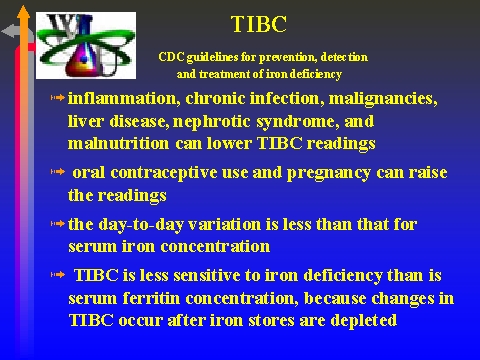Slide 33 of 43
Notes:
TIBC is a measure of the iron-binding capacity within the serum and reflects the availability of iron-binding sites on transferrin (94). Thus, TIBC increases when serum iron concentration (and stored iron) is low and decreases when serum iron concentration (and stored iron) is high. Factors other than iron status can affect results from this test. For example, inflammation, chronic infection, malignancies, liver disease, nephrotic syndrome, and malnutrition can lower TIBC readings, and oral contraceptive use and pregnancy can raise the readings (87,102 ). Nevertheless, the day-to-day variation is less than that for serum iron concentration (87,101 ). TIBC is less sensitive to iron deficiency than is serum ferritin concentration, because changes in TIBC occur after iron stores are depleted ( 17,31,94 ).
[17]. Bothwell TH, Chadton RW, Cook JD, Finch CA. Iron metabolism in man. Oxford, UK: Blackwell Scientific Publications, 1979.
[31]. Baynes RD. Iron deficiency. In: Brock JH, Halliday JW, Pippard M J, Powell LW, eds. Iron metabolism in health and disease. London, UK: W.B. Saunders, 1994:189-225.
[87]. Beaton GH, Corey PN, Steele C. Conceptual and methodological issues regarding the epidemiology of iron deficiency and their implications for studies of the functional consequences of iron deficiency. Am J Clin Nutr 1989;50:575-88.
[94]. Gibson RS. Principles of nutritional assessment. New York, NY: Oxford University Press, 1990.
[101]. Looker AC, Sempos CT, Liu K, Johnson CL, Gunter EW. Within person variance in biochemical indicators of iron status: effects on prevalence estimates. Am J Clin Nutr 1990;52:541-7.
[102]. Brittenham GM. Disorders of iron metabolism: iron deficiency and overload. In: Hoffman R, Benz EJ Jr, Shattil S J, Furie B, Cohen H J, eds. Hematology: basic principles and practice. 2rid ed. New York, NY: Churchill Livingstone, 1995:492-523.















